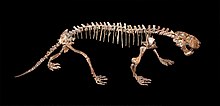Sauroctonus
| Sauroctonus Temporal range:
| |
|---|---|

| |
| Sauroctonus parringtoni | |

| |
| Scientific classification | |
| Domain: | Eukaryota |
| Kingdom: | Animalia |
| Phylum: | Chordata |
| Clade: | Synapsida |
| Clade: | Therapsida |
| Clade: | †Gorgonopsia |
| Family: | †Gorgonopsidae |
| Genus: | †Sauroctonus Bystrow, 1955 |
| Species | |
| |
Sauroctonus is an extinct genus of therapsids. Sauroctonus progressus was a large (2 m long) gorgonopsid that lived in the Late Permian epoch before the Permian-Triassic extinction event that wiped out many life forms on Earth (259-254 million years ago). Its fossils have been found in the Usili Formation (Songea Group) of Tanzania and the Sokolki Assemblage Zone of the Volga Basin of Russia.
Description
Sauroctonus's flattened, triangular skull was about 25 cm (9.8 in) long, with a parietal eye, a primitive character, on the crown. The upper and lower jaw each contained one pair of massive canine teeth (the upper pair was larger); the other teeth were smaller, but were also sharp and pointed. In addition, minute, blunt teeth were present on the palatine bones. The lower jaw was widened to form a kind of chin. The long, lightly built, five-toed limbs bore a resemblance to mammals' limbs, but despite its 'mammalian' characteristics, Sauroctonus was not one of the ancestors of mammals. Based on its cranial and skeletal features, Sauroctonus was not as specialized as other gorgonopsids such as Rubidgea or Inostrancevia.[1]
Species
There are two recognized species of Sauroctonus: S. progressus and S. parringtoni.[2]
Gallery
-
Sauroctonus parringtoni
-
Sauroctonus progressus
See also
References
- ^ Anton, Mauricio (2013). Sabertooth.
- ^ Gebauer E I, 2014. Re-assessment of the taxonomic position of the specimen GPIT/RE/7113 (Sauroctonus parringtoni comb. nov., Gorgonopsia). In: Kammerer C F, Angielczyk K D, Fröbisch J eds. Early Evolutionary History of the Synapsida. Dordrecht: Springer. 185−207.
Further reading
- Benes, Josef. Prehistoric Animals and Plants. Pg. 95. Prague: Artia, 1979.




